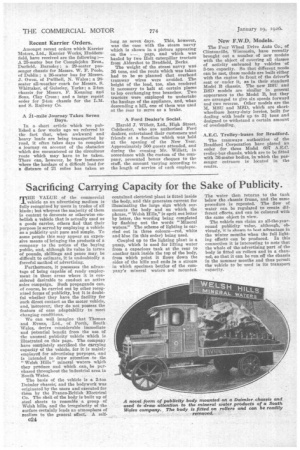Sacrificing Carrying Capacity for the Sake of Publicity.
Page 8

If you've noticed an error in this article please click here to report it so we can fix it.
MHE VALUE of the commercial
vehicle as an advertising medium is fully recognized by users in trades of all kinds; but whereas the majority of them is content to decorate or otherwise embellish a vehicle that is actually used as a goods carrier, others find that their purpose is served by employing a vehicle as a publicity unit pure and simple. To some people this may appear an expensive means of bringing the products of a company to the notice of the buying public, and, although its value in terms of pounds, shillings and pence may be difficult to estimate, it is undoubtedly a forceful method of advertising.
Furthermore, it possesses the advantage of being capable of ready employment in those areas where it is considered desirable to conduct an active sales campaign. Such propaganda can, of course, be carried out by other recognized forms of publicity, but it is doubtful whether they have the facility for such direct contact as the motor vehicle, and, Moreover, they do not possess the feature of ease adaptability to meet changing conditions.
We can well imagine that Thomas and Evans, Ltd., of Forth, South Wales, derive etinsiderable immediate and potential benefit from the use of the unusual publicity vehicle which is illustrated on this page. The company have completely sacrificed the carrying capacity of the vehicle, for it is mainly employed for advertising purpoaes, and is intended to draw attention to the "Welsh 'Frills" mineral waters which they preduce and which can, be purchased throughout the industrial area in South Wales.
The basis of the vehicle is a 2-ton Daimler chassis; and the bodywork was originated by the users and executed for them by the Franco-British Electrical Co. The shell of the body is built up of steel sheets to resemble a group of Welsh hills, and the irregularity of the surface certainly lends an atmosphere of realism to the general effect. A self
contained electrical plant is fitted inside the body, and this generates current far illuminating the large sign which surmounts the body and on which the phrase, " Welsh Hills," is spelt out letter by letter, the wording being completed by flashing out the words "Mineral waters." The scheme of lighting is carried out in three colours—red, white and blue (in this order) being used.
Coupled up to the lighting plant is a pump, which is used for lifting water from a capacious tank at the rear to another tank inside the top of the body, from which point it flows down the sides of the hills and ends in a stream in which specimen bottles of the company's mineral waters are mounted.
The water then returns to the tank below the chassis frame, and the same procedure is repeated. The flow of water can be regulated to create different effects, and can be coloured with the same object in view.
The vehicle can claim an all-the-yearround publicity value, although, obviously, it is shown to hest advantage in the winter menths when the full lighting effects can be produced. In this connection it is interesting to note that the whole of the advertising part of the body is fitted on rollers and in a channel, so that it can be run off the chassis in the summer months and thus permit the vehicle to be used in its transport capacity.






























